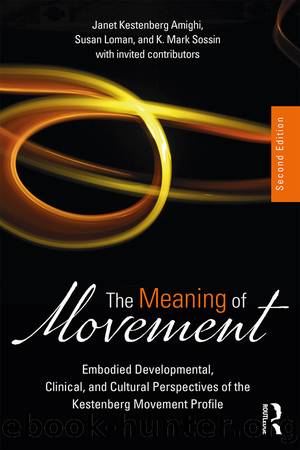The Meaning of Movement by Janet Kestenberg Amighi Susan Loman K. Mark Sossin & Susan Loman & K. Mark Sossin

Author:Janet Kestenberg Amighi,Susan Loman,K. Mark Sossin & Susan Loman & K. Mark Sossin
Language: eng
Format: epub
Publisher: Taylor & Francis (CAM)
Development of Abstract Thought and Language: Most of the early gestures of pointing are used for declarative purposes, as in âThereâs grandma,â or âLook at that,â (Esteve-Gibert & Prieto, 2013). Kestenberg proposed that pointing to an object helps give it definition and paves the way for the labeling process of verbal language and abstract thought (Kestenberg, 1967b).
Later studies by psychologists and communication specialists support and extend Kestenbergâs thesis. Some researchers emphasize the extent to which the mind is embodied. In this view, the body is not an adjunct to thinking, but integral to it (Wilson & Golonka, 2013). For example, John McNeil (2007) says that he sees âgestures as active participants in speaking and thinking. They are conceived of as ingredients in an imagery-language dialectic that fuels speech and thoughtâ (2007, kindle loc. 92).
The first perceptions of infants come through moving in their environment. Their thinking emerges from bodily experiences or is embodied in them (Kinsbourne, 2006). Asking for more food by gesturing to the mouth extends a bodily task into a communication. Raising arms to signal a desire to be picked up, reproduces the feeling of being picked up, and may well serve as a foundation for pointing to something desired. Those embodiments, when observed in adults, are likely âto be residuals of their infant originsâ (Kinsbourne, 2006, p. 208).
Like Kestenberg, McNeil (1985) specifies pointing as the first gesture children use to represent an abstraction of an object. But we would suggest that it represents a certain type of abstraction. [Directional] gesture production is associated with linearization in thought (Melinger & Kita, 2007). More specifically, Ekman and Friesen (1972) suggest that certain types of movements (ideographs) sketch the path or direction of thought, literally or metaphorically. For example, as described earlier, there is a frequent association between a speakerâs use of a backward and upward gesture of the head (directional movements) and the process of recalling the past.
In an experiment conducted by Goldmanâs (1990) study group, speakers and listeners were asked to maintain continuous eye contact. The listeners were able to sustain eye contact (using a directional gaze) without any difficulty. The speakers, however, could not do so unless they were reciting by rote. In order to mentally access information for use in their speech, they apparently needed to be able to shift their gaze from place to place. A single directional gaze limited the speaker to a single train of thought (Goldman, Kestenberg, Maloney, Sherman, & Walker, 1988). This result is supported by a study of Argyle and Cook (1976) that found that while listeners typically made eye contact 70% of the time, speakers did so only about 40% of the time, shifting their gaze as their thought patterns shift.
Kestenberg noted that âAim-directed movements such as pointing precede language development, but continue to be the language of movement throughout lifeâ (1967b, p. 101). She added that locating objects in space can serve as a precursor of verbal communication.
In a review of a number of studies, Rime and Schiaratura (1991, p.
Download
This site does not store any files on its server. We only index and link to content provided by other sites. Please contact the content providers to delete copyright contents if any and email us, we'll remove relevant links or contents immediately.
The European History Highway: A Guide to Internet Resources by Dennis A. Trinkle Scott A. Merriman(498)
The Seven Wonders of the Ancient World by Michael Denis Higgins(479)
European Security in a Global Context by Thierry Tardy(472)
European Security without the Soviet Union by Stuart Croft Phil Williams(472)
The Routledge companion to Christian ethics by D. Stephen Long Rebekah L. Miles(460)
Hudud Al-'Alam 'The Regions of the World' - a Persian Geography 372 A.H. (982 AD) by V. V. Minorsky & C. E. Bosworth(402)
Gorbachev And His Generals by William C. Green(393)
Get Real with Storytime by Julie Dietzel-Glair & Marianne Crandall Follis(391)
Tibetan Studies in Comparative Perspective by Chih-yu Shih Yu-Wen Chen(387)
Governance, Growth and Global Leadership by Espen Moe(385)
Hyperculture by Byung-Chul Han(379)
CliffsNotes on Fitzgerald's The Great Gatsby by Kate Maurer(362)
The Oxford History of the World by Fernández-Armesto Felipe;(356)
How Languages Are Learned 5th Edition by Patsy M Lightbown;Nina Spada; & Nina Spada(355)
The Egyptian Economy, 1952-2000 by Khalid Ikram(354)
Oral Poetry and Narratives from Central Arabia: The Poetry of Ad-Dindan : A Bedouin Bard in Southern Najd (Studies in Arabic Literature, Vol 17) (English and Arabic Edition) by P. M. Kupershoek P. Marcel Kurpershoek(345)
The Oxford Handbook of the Incas by Sonia Alconini(336)
Europe Contested by Harold James(323)
The Hutchinson Dictionary of Ancient and Medieval Warfare by Peter Connolly John Gillingham John Lazenby(307)
